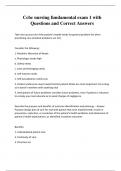Ccbc nursing fundamental exam 1 with
Questions and Correct Answers
Take into account all of the patient's health needs for general problem list when
prioritizing care (medical problems are 1st)
Consider the following:
1. Maslow's Hierarchy of Needs
a. Physiologic needs High
b. Safety needs
c. Love and belonging needs
d. Self-esteem needs
e. Self-actualization needs Low
2. Patient preference-meet needs that the patient thinks are most important 1st as long
as it doesn't interfere with anything vital
3. Anticipation of future problems-consider future problems, even if patient is reluctant
to comply you must educate as to avoid charges of negligence
Describe the purpose and benefits of outcome identification and planning. - Answer
Purpose-design plan of care for and with patient that once implemented, results in
prevention, reduction, or resolution of the patient's health problems and attainment of
patient's health expectations, as identified in patient outcomes
Benefits:
1. Individualized patient care
2. Continuity of care
3. Priorities set
,4. Coordinate care
5. Promote nurse's professional development
6. Create record used for evaluation, reimbursement, and legal purposes
7. Facilitate communication
Describe means to validate nursing diagnosis - Answer 1. Is patient database accurate?
2. Does the data demonstrate a existence of pattern?
3. Are the subjective and objective data characteristic of the health problem?
4. Is nursing diagnosis based on scientific nursing knowledge and clinical expertise?
5. Is the nursing diagnosis able to be prevented, reduced, or resolved by independent
nursing action?
6. Is my degree of confidence above %50?
Identify five types of nursing diagnosis - Answer Actual, Risk, Health promotion,
Wellness
Use the guidelines for writing nursing diagnoses when developing diagnostic
statements. - Answer 1. phrase the nursing diagnosis as a patient problem rather than a
patient need
2.Check to make sure patient problem preceds the etiology and the two are linked by
"related to"
3. write in legally advisable terms
4. use nonjudgmental language
5. be sure to include what is unhealthy about the patient
6.avoid using medical diagnosis, defining characteristics
Describe the four steps involved in data interpretation and analysis. - Answer 2. (1)
Changes in a pts usual health patterns that are unexplained by expected norms for
,growth & development: ex infant who took to breastfeeding easily as newborn suddenly
stops sucking when put to breast & begins to lose wt.
(2) Deviation from an appropriate population norm: ex A first-year college student
begins to accelerate her exercise habits dramatically & starts inducing vomiting after
binge eating. She rapidly loses wt.
(3) Behavior that is nonproductive in the whole-person context: Ex college student
breaks up w/her bf & begins to believe that she is "unfit" for any relationship,
withdrawing from her friends & social activites.
(4) Behavior that indicates a developmental alg or evolving dysfunctional pattern: Ex. 16
y/o single mother w/a 6mnt old infant continues to "party hard" w/friends, hang out at
mall, an shows no interest in caring for her son, who is repeatedly left w/concerned
family members.
Describe the term nursing diagnosis, distinguishing it from a collaborative problem and a
medical diagnosis. - Answer Medical diagnosis identifies diseases, whereas nursing
diagnoses focus on unhealthy responses to health and illness.
Collaborative problem are the primary responsibility of the nurses. The prescription for
treatment comes from nursing, medicine, and other disciplines. When a nurse writes
patient outcomes that require delegated medical orders for goal achievement, the
situation is not a nursing diagnosis
characteristics of data - Answer purposeful, complete, factual and accurate, relevant
Describe the importance of knowing when to report significant patient data and of
proper documentation. - Answer Reporting: data should be reported verbally
immediately whenever assessment findings reveal a critical change in pts health status
that necessitates the involvement of other nurses or health care professionals.
Ex. Nurse who observers elevated temp 103.2 F in pt scheduled for sx that morning
must report this to charge nurse & surgeon, who might cancel sx.
Documentation: Pts initial databse is entered in computer or recorded in ink, using
designated agency protocol or forms, the same day pt is admitted to agency. If for any
, reason, impt data cannot be obtained during initial assessment, this should be doc. so
that the are obtained as soon as possible.
Identify common problems encountered in data collection, noting their possible causes.
- Answer Inappropriate organization of the database, omission of pertinent data,
inclusion of irrelevant or duplicate data, erroneous or misinterpreted data, failure to
estb rapport & partnership w/pt, recording an interpretation of data rather than
observed behavior, & failure to update the database
identify common prolems encountered in data collection, noting possible causes -
Answer database inappropriately organized- failure to plan for assessment by
identifying needed data,
pertinent data omitted-not following up on cues during data collection, inappropriate
guidelines
erroneuous or misinterpretted data collection- failure to observe carefully or validate
during data collection, interviewer prejudice or stereotypes
failure to establish rapport-failure to know what info is wanted
interpretation of data is recorded rather than the observed behavior- nurse jumps to
conclusions
failure to update the database- erroneuous belief that assessment is concluded after
intitial database is recorded
obtain a nursing history using effective interviewing techniques? - Answer The nursing
history should clearly identify the patients strengths and weaknesses; health risk, such




